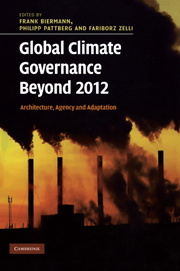Book contents
- Frontmatter
- Contents
- List of contributors
- Preface
- List of abbreviations
- 1 Global climate governance beyond 2012
- Part I Architecture
- Part II Agency
- 9 Agency in global climate governance
- 10 The role and relevance of networked climate governance
- 11 Carbon market governance beyond the public–private divide
- 12 A staged sectoral approach for climate mitigation
- 13 Technological change and the role of non-state actors
- Part III Adaptation
- Index
- References
13 - Technological change and the role of non-state actors
Published online by Cambridge University Press: 05 July 2014
- Frontmatter
- Contents
- List of contributors
- Preface
- List of abbreviations
- 1 Global climate governance beyond 2012
- Part I Architecture
- Part II Agency
- 9 Agency in global climate governance
- 10 The role and relevance of networked climate governance
- 11 Carbon market governance beyond the public–private divide
- 12 A staged sectoral approach for climate mitigation
- 13 Technological change and the role of non-state actors
- Part III Adaptation
- Index
- References
Summary
Introduction
This chapter addresses technological change as a key response to the challenge of climate change and focuses on the roles of private and government sectors in providing emissions reductions throughout this century. While standard economic theory recommends that governments set a price on emissions (Pigou 1920), we argue that market imperfections and dynamic inconsistencies may require that in addition, governments support far-reaching technological change by means of publicly funded research, development and demonstration. In fact, public funding of research and development and carbon pricing policies are, at least in theory, mutually supportive and should not be seen as unbridgeable alternatives.
The Kyoto Protocol may fail to meet even its modest goals. This underscores the need for more far-reaching technological change. The political target of avoiding a temperature increase greater than 2 °C – the European Union target – may already be beyond reach. The Stern Review (Stern 2007) estimates that stabilizing the greenhouse gas concentration level at 550 ppm carbon dioxide-equivalents by the middle of this century should avoid the most dangerous climate changes. Figure 13.1, adopted from the Stern Review, illustrates what stabilization targets of 550 ppm carbon dioxide-equivalents and below will imply in terms of emissions reductions by industrialized and developing countries. These targets aim at eliminating greenhouse gas emissions by industrialized nations by the end of the century.
- Type
- Chapter
- Information
- Global Climate Governance Beyond 2012Architecture, Agency and Adaptation, pp. 208 - 220Publisher: Cambridge University PressPrint publication year: 2010
References
- 2
- Cited by



